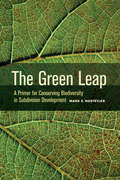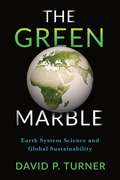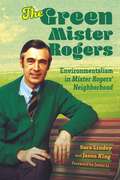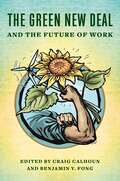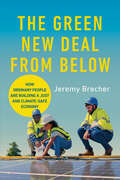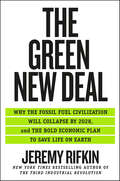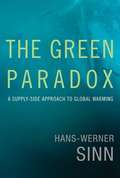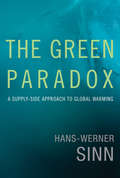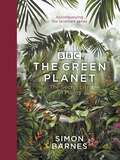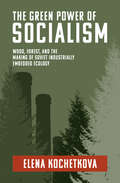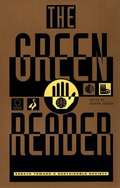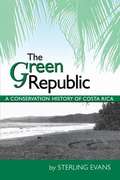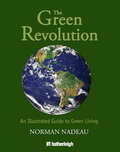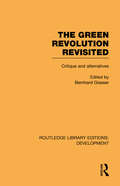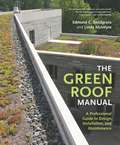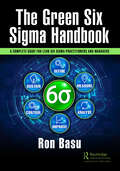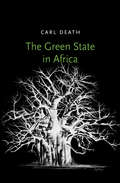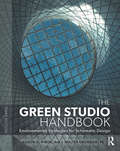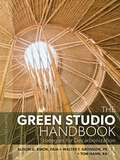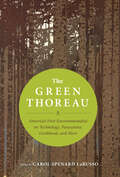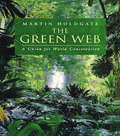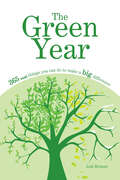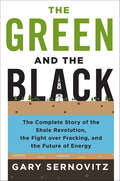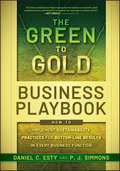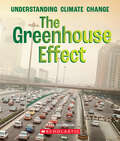- Table View
- List View
The Green Leap
by Mark E. HostetlerWritten for anyone interested in green development--including policy makers, architects, developers, builders, and homeowners--this practical guide focuses on the central question of how to conserve biodiversity in neighborhoods and to minimize development impacts on surrounding habitats. The Green Leap specifically helps move green development beyond the design stage by thoroughly addressing construction and post-construction issues. Incorporating many real-world examples, Mark Hostetler explains key conservation concepts and techniques, with specific advice for a wide variety of stakeholders that are interested in creating and maintaining green developments. He outlines the key players and principles needed to establish biodiverse communities and illustrates eight key design and management strategies. The Green Leap not only offers essential information for constructing new developments but also helps existing communities retrofit homes, yards, and neighborhoods to better serve both people and nature.
The Green Marble: Earth System Science and Global Sustainability
by David TurnerHumans have difficulty thinking at the global scale. Yet as we come to understand our planet as a single, interconnected, complex system and encounter compelling evidence of human impact on Earth’s climate and biosphere, the need for a truly global effort is increasingly urgent. In this concise and accessible text, David P. Turner presents an overview of global environmental change and a synthesis of research and ideas from the rapidly evolving fields of earth system science and sustainability science that is suitable for anyone interested in humanity’s current predicaments and what we can do about them.The Green Marble examines Earth’s past, contemporary human disruption, and the prospects for global environmental governance. Turner emphasizes the functioning of the biosphere—the totality of life on Earth—including its influence on geologic history, its sensitivity to human impacts, and its possible role in ameliorating climate change. Relying on models of the earth system that synthesize vast amounts of monitoring information and recent research on biophysical processes, The Green Marble describes a range of scenarios for our planetary home, exploring the effects of anthropogenic greenhouse gas emissions and factors such as economic globalization. Turner juxtaposes cutting-edge ideas from both the geosciences and the social sciences to illustrate how humanity has arrived upon its current dangerous trajectory, and how we might pull back from the brink of civilization-challenging environmental change. Growing out of the author’s popular course on global environmental change, The Green Marble is accessible to non-science majors and provides a framework for understanding the complex relationship of humanity to the global environment.
The Green Mister Rogers: Environmentalism in Mister Rogers' Neighborhood (Children's Literature Association Series)
by Jason King Sara LindeyFred Rogers was an international celebrity. He was a pioneer in children’s television, an advocate for families, and a multimedia artist and performer. He wrote the television scripts and music, performed puppetry, sang, hosted, and directed Mister Rogers’ Neighborhood for more than thirty years. In his almost nine hundred episodes, Rogers pursued dramatic topics: divorce, death, war, sibling rivalry, disabilities, racism. Rogers’ direct, slow, gentle, and empathic approach is supported by his superior emotional strength, his intellectual and creative courage, and his joyful spiritual confidence. The Green Mister Rogers: Environmentalism in “Mister Rogers’ Neighborhood” centers on the show’s environmentalism, primarily expressed through his themed week “Caring for the Environment,” produced in 1990 in coordination with the twentieth anniversary of Earth Day. Unfolding against a trash catastrophe in the Neighborhood of Make-Believe, Rogers advances an environmentalism for children that secures children in their family homes while extending their perspective to faraway places, from the local recycling center to Florida’s coral reef. Rogers depicts animal wisdom and uses puppets to voice anxiety and hope and shows an interconnected world where each part of creation is valued, and love is circulated in networks of care. Ultimately, Rogers cultivates a practical wisdom that provides a way for children to confront the environmental crisis through action and hope and, in doing so, develop into adults who possess greater care for the environment and a capacious imagination for solving the ecological problems we face.
The Green New Deal and the Future of Work
by Raj Patel Harvey Molotch Harry C. Boyte Richard Lachmann Stephanie Luce Richard A. Walker Clark A. Miller Trygve Throntveit Alyssa Battistoni Daniel Aldana Cohen Hillary Angelo Olúfẹ́mi O. Táíwò Jim Goodman Wilson Sherwin Dustin Guastella Mindy Isser Todd E. Vachon J. Mijin Cha Lara SkinnerCatastrophic climate change overshadows the present and the future. Wrenching economic transformations have devastated workers and hollowed out communities. However, those fighting for jobs and those fighting for the planet have often been at odds. Does the world face two separate crises, environmental and economic? The promise of the Green New Deal is to tackle the threat of climate change through the empowerment of working people and the strengthening of democracy. In this view, the crisis of nature and the crisis of work must be addressed together—or they will not be addressed at all.This book brings together leading experts to explore the possibilities of the Green New Deal, emphasizing the future of work. Together, they examine transformations that are already underway and put forth bold new proposals that can provide jobs while reducing carbon consumption—building a world that is sustainable both economically and ecologically. Contributors also debate urgent questions: What is the value of a federal jobs program, or even a jobs guarantee? How do we alleviate the miseries and precarity of work? In key economic sectors, including energy, transportation, housing, agriculture, and care work, what kind of work is needed today? How does the New Deal provide guidance in addressing these questions, and how can a Green New Deal revive democracy? Above all, this book shows, the Green New Deal offers hope for a better tomorrow—but only if it accounts for work’s past transformations and shapes its future.
The Green New Deal from Below: How Ordinary People Are Building a Just and Climate-Safe Economy
by Jeremy BrecherA visionary program for national renewal, the Green New Deal aims to protect the earth’s climate while creating good jobs, reducing injustice, and eliminating poverty. Its core principle is to use the necessity for climate protection as a basis for realizing full employment and social justice. Jeremy Brecher goes beyond the national headlines and introduces readers to the community, municipal, county, state, tribal, and industry efforts advancing the Green New Deal across the United States. Brecher illustrates how such programs from below do the valuable work of building constituencies and providing proofs of concept for new ideas and initiatives. Block by block, these activities have come together to form a Green New Deal built on a strong foundation of small-scale movements and grassroots energy. A call for hope and a better tomorrow, The Green New Deal from Below offers a blueprint for reconstructing society on new principles to avoid catastrophic climate change.
The Green New Deal: Why the Fossil Fuel Civilization Will Collapse by 2028, and the Bold Economic Plan to Save Life on Earth
by Jeremy RifkinNew York Times–Bestselling Author: The renowned economic theorist explains how America can—and must—create a post-fossil fuel culture to survive.We can’t keep doing business as usual. Facing a global emergency, a younger generation has spearheaded a national conversation around a Green New Deal—a movement with the potential to revolutionize society. But while the Green New Deal has become a lightning rod in the political sphere, there is a parallel movement emerging within the business community that will shake the very foundation of the global economy in coming years.Key sectors of the economy are fast-decoupling from fossil fuels in favor of ever-cheaper solar and wind energies and the new business opportunities and employment that accompany them. New studies are sounding the alarm that trillions of dollars in stranded fossil fuel assets could create a carbon bubble likely to burst by 2028, causing the collapse of the fossil fuel civilization. The marketplace is speaking, and governments will need to adapt if they are to survive and prosper.In The Green New Deal, Jeremy Rifkin delivers the political narrative and economic plan for the Green New Deal that we need at this critical moment in history. The concurrence of a stranded fossil fuel assets bubble and a green political vision opens up the possibility of a massive shift to a post-carbon ecological era, in time to prevent a temperature rise that will tip us over the edge into runaway climate change. With twenty-five years of experience implementing Green New Deal–style transitions for both the European Union and the People’s Republic of China, Rifkin offers his vision for how to transform the global economy and save life on Earth.“The Green New Deal takes a stance quite different from that of typical Green New Deal supporters . . . he’s interested in building factories, farms, and vehicles in a fossil-free world, asserting that ‘the Green New Deal is all about infrastructure.’” —The New York Times Book Review“An urgent endorsement of efforts to remake a doomed fossil-fuel economy before it’s too late.” —Kirkus Reviews
The Green Paradox
by Hans-Werner SinnThe Earth is getting warmer. Yet, as Hans-Werner Sinn points out in this provocative book, the dominant policy approach--which aims to curb consumption of fossil energy--has been ineffective. Despite policy makers' efforts to promote alternative energy, impose emission controls on cars, and enforce tough energy-efficiency standards for buildings, the relentlessly rising curve of CO2 output does not show the slightest downward turn. Some proposed solutions are downright harmful: cultivating crops to make biofuels not only contributes to global warming but also uses resources that should be devoted to feeding the world's hungry. In The Green Paradox, Sinn proposes a new, more pragmatic approach based not on regulating the demand for fossil fuels but on controlling the supply. The owners of carbon resources, Sinn explains, are pre-empting future regulation by accelerating the production of fossil energy while they can. This is the "Green Paradox": expected future reduction in carbon consumption has the effect of accelerating climate change. Sinn suggests a supply-side solution: inducing the owners of carbon resources to leave more of their wealth underground. He proposes the swift introduction of a "Super-Kyoto" system--gathering all consumer countries into a cartel by means of a worldwide, coordinated cap-and-trade system supported by the levying of source taxes on capital income--to spoil the resource owners' appetite for financial assets. Only if we can shift our focus from local demand to worldwide supply policies for reducing carbon emissions, Sinn argues, will we have a chance of staving off climate disaster.
The Green Paradox: A Supply-Side Approach to Global Warming
by Hans-Werner SinnA leading economist develops a supply-side approach to fighting climate change that encourages resource owners to leave more of their fossil carbon underground.The Earth is getting warmer. Yet, as Hans-Werner Sinn points out in this provocative book, the dominant policy approach—which aims to curb consumption of fossil energy—has been ineffective. Despite policy makers' efforts to promote alternative energy, impose emission controls on cars, and enforce tough energy-efficiency standards for buildings, the relentlessly rising curve of CO2 output does not show the slightest downward turn. Some proposed solutions are downright harmful: cultivating crops to make biofuels not only contributes to global warming but also uses resources that should be devoted to feeding the world's hungry. In The Green Paradox, Sinn proposes a new, more pragmatic approach based not on regulating the demand for fossil fuels but on controlling the supply.The owners of carbon resources, Sinn explains, are pre-empting future regulation by accelerating the production of fossil energy while they can. This is the “Green Paradox”: expected future reduction in carbon consumption has the effect of accelerating climate change. Sinn suggests a supply-side solution: inducing the owners of carbon resources to leave more of their wealth underground. He proposes the swift introduction of a “Super-Kyoto” system—gathering all consumer countries into a cartel by means of a worldwide, coordinated cap-and-trade system supported by the levying of source taxes on capital income—to spoil the resource owners' appetite for financial assets.Only if we can shift our focus from local demand to worldwide supply policies for reducing carbon emissions, Sinn argues, will we have a chance of staving off climate disaster.
The Green Planet: (ACCOMPANIES THE BBC SERIES PRESENTED BY DAVID ATTENBOROUGH)
by Simon BarnesPraise for The Green Planet (BBC One)'David Attenborough's gobsmacking, awe-inspiring return' The Guardian'The Green Planet reveals the secret lives of plants in the same way The Blue Planet opened our eyes to the oceans' New ScientistThere's something new under the sunPlants live secret, unseen lives - hidden in their magical world and on their timescale. From the richest jungles to the harshest deserts, from the snowiest alpine forest to the remotest steaming swamp, Green Planet travels from one great habitat to the next, showing us that plants are as aggressive, competitive and dramatic as the animals on our planet. You will discover agents of death, who ruthlessly engulf their host plant, but also those that form deep and complex relationships with other species, such as the desert cacti who use nectar-loving bats to pollinate. Although plants are undoubtedly the stars of the show, a fascinating new light will be shed on the animals that interact with them.Using the latest technologies and showcasing over two decades of new discoveries, Green Planet reveals the strange and wonderful life of plants like never before - a life full of remarkable behaviour, emotional stories and surprising heroes.
The Green Power of Socialism: Wood, Forest, and the Making of Soviet Industrially Embedded Ecology (History for a Sustainable Future)
by Elena KochetkovaHow the Soviet forestry industry developed a unique form of industrial ecology—a commonsense approach toward natural resources for the economy and society.In The Green Power of Socialism, Elena Kochetkova examines the relationship between nature and humans under state socialism by looking at the industrial role of Soviet forests. The book explores evolving Soviet policies of wood consumption, discussing how professionals working in the forestry industry of the Soviet state viewed the present and future of forests by considering them both a natural resource and a trove of industrial material. When faced with the prospect of wood shortages, these specialists came to develop new industry-ecology paradigms. Kochetkova looks at the materiality of Soviet industry through forests and wood to show how, paradoxically, industrial ecology emerged and developed as a by-product of the Soviet industrialization project.The Green Power of Socialism also discusses how post-Soviet industry has abandoned these socialist practices and the idea of nature as a complicated ecosystem that provides a crucial service to society. Emphasizing the technological and environmental impacts of the Cold War, Kochetkova critically reconsiders two explanatory models that have become dominant in the historiography of Soviet approaches to nature over the last decades—ecocide and environmentalism. Within the context of the current environmental crisis, the book invites readers to reevaluate state socialism as a complex phenomenon with sophisticated interactions between nature and industry. In so doing, it contributes a fresh perspective on the activities of socialist experts and their view of nature, shedding light on Soviet state industrial and environmental policy and its continuing legacy in the present day.
The Green Reader: Essays Toward a Sustainable Society
by Andrew DobsonThe Green Reader collects key source documents of today's most important social/scientific/philosophical movement-the Green movement.
The Green Republic: A Conservation History of Costa Rica
by Sterling EvansWith over 25 percent of its land set aside in national parks and other protected areas, Costa Rica is renowned worldwide as "the green republic. " In this very readable history of conservation in Costa Rica, Sterling Evans explores the establishment of the country's national park system as a response to the rapid destruction of its tropical ecosystems due to the expansion of export-related agriculture. Drawing on interviews with key players in the conservation movement, as well as archival research, Evans traces the emergence of a conservation ethic among Costa Ricans and the tangible forms it has taken. In Part I, he describes the development of the national park system and "the grand contradiction" that conservation occurred simultaneously with massive deforestation in unprotected areas. In Part II, he examines other aspects of Costa Rica's conservation experience, including the important roles played by environmental education and nongovernmental organizations, campesino and indigenous movements, ecotourism, and the work of the National Biodiversity Institute.
The Green Revolution
by Norman NadeauEver Wonder What A Green Renewable Sustainable World Would Look Like?With the state of our world and its limited resources, more and more people are trying to lead a greener lifestyle in order to do their part. The Green Revolution provides comprehensive information associated with adopting daily practices that will ultimately sustain, not deplete, precious natural materials in an ever-growing population.Renewable energy expert Norman Nadeau leads by example as he details how he has committed his life to living green. From the application of solar and wind turbine technology, to recovering energy embedded in places one may not expect (such as animals' manure), The Green Revolution highlights the highly sustainable system Norman Nadeau developed for his family farm.The Green Revolution serves as a broad introduction for those who want to conserve rather than squander. At this very important turning point in our planet's history, this book offers the principles by which anyone can live in the most sustainable way possible.
The Green Revolution Revisited: Critique and Alternatives (Routledge Library Editions: Development)
by Bernhard GlaeserThe Green Revolution – the apparently miraculous increase in cereal crop yields achieved in the 1960s – came under severe criticism in the 1970s because of its demands for optimal irrigation, intensive use of fertilisers and pesticides; its damaging impact on social structures; and its monoculture approach. The early 1980s saw a concerted approach to many of these criticisms under the auspices of Consultative Group on International Agricultural Research (CGIAR). This book, first published in 1987, analyses the recent achievements of the CGIAR and examines the Green Revolution concept in South America, Asia and Africa, from an ‘ecodevelopment’ standpoint, with particular regard to the plight of the rural poor. The work is characterised by a concern for the ecological and social dimensions of agricultural development,which puts the emphasis on culturally compatible, labour absorbing and environmentally sustainable food production which will serve the long term needs of developing countries.
The Green Roof Manual: A Professional Guide to Design, Installation, and Maintenance
by Linda McIntyre Edmund C. SnodgrassGreen roofs—the ultimate in sustainable building practices—continue to generate enormous interest and enthusiasm among architects, landscape designers, and urban planners. Increasingly strict stormwater regulations and the appeal of LEED-related projects have also boosted the popularity and desirability of green roofs. Those who want to build green roofs, however, have few resources to guide them. Until now, no book has taken a comprehensive look at how to effectively adapt green-roof technology to the variable and extreme North American climate, and how to design projects that will function and endure as successfully as those in Germany, Switzerland, and other European countries. This book fills the gap by providing an overview of practices and techniques that have been effective in North America. The authors offer options regarding structure, function, horticulture, and logistics, as well as surveys of actual projects and analyses of why they have or haven’t succeeded. Approachable and reader-friendly, the manual clearly explains how these complex systems function and how to plan and carry out projects successfully from concept through construction and maintenance. Ideally suited to professionals (including architects, landscape architects, engineers, and designers) and their clients, it brings together key lessons from leaders in the field. Numerous photographs highlight the range of design possibilities and show green roofs both during construction and at various stages of maturity. At last, those seeking basic information about how to design and build green roofs have a concise, authoritative guide to this exciting new technology.
The Green Six Sigma Handbook: A Complete Guide for Lean Six Sigma Practitioners and Managers
by Ron BasuThis book is a hands-on single-source reference of tools, techniques, and processes integrating both Lean and Six Sigma. This comprehensive handbook provides up-to-date guidance on how to use these tools and processes in different settings, such as start-up companies and stalled projects, as well as establish enterprises where the ongoing drive is to improve processes, profitability, and long-term growth. It contains the "hard" Six Sigma approach as well as the flexible approach of FIT SIGMA, which is adaptable to manufacturing and service industries and also public sector organisations. You will also discover how climate change initiatives can be accelerated to sustainable outcomes by the holistic approach of Green Six Sigma. The book is about what we can do now with leadership, training, and teamwork in every sphere of our businesses. Lean, originally developed by Toyota, is a set of processes and tools aimed at minimising wastes. Six Sigma provides a set of data-driven techniques to minimise defects and improve processes. Integrating these two approaches provides a comprehensive and proven approach that can transform an organisation. To make change happen, we need both digital tools and analog approaches. We know that there has been a continuous push to generate newer approaches to operational excellence, such as Total Quality Management, Six Sigma, Lean Sigma, Lean Six Sigma, and FIT SIGMA. It is vital that we harness all our tools and resources to regenerate the economy after the Covid-19 pandemic and make climate change initiatives successful for the survival of our planet. Six Sigma and its hybrids (e.g., Lean Six Sigma) should also play a significant part. Over the last three decades, operational performance levels of both public sector and private sector organisations improved significantly and Lean Six Sigma has also acted as a powerful change agent. We urgently need an updated version of these tools and approaches. The Green Six Sigma Handbook not only applies appropriate Lean and Six Sigma tools and approaches, fitness for the purpose, but it aims at sustainable changes. This goal of sustainability is a stable bridge between Lean Six Sigma and climate change initiatives. Hence, when the tools and approaches of Lean Six Sigma are focused and adapted primarily to climate change demands, we get Green Six Sigma.
The Green State in Africa
by Carl DeathA provocative reassessment of the relationship between states and environmental politics in Africa From climate-related risks such as crop failure and famine to longer-term concerns about sustainable urbanization, environmental justice, and biodiversity conservation, African states face a range of environmental issues. As Carl Death demonstrates, the ways in which they are addressing them have important political ramifications, and challenge current understandings of green politics. Death draws on almost a decade of research to reveal how central African environmental politics are to the transformation of African states.
The Green Studio Handbook: Environmental Strategies for Schematic Design
by Alison G Kwok Walter GrondzikThe Green Studio Handbook remains an essential resource for design studios and professional practice. This extensive and user-friendly tool presents practical guidelines for the application of green strategies during the schematic design of buildings. Students and professionals can quickly get up to speed on system viability and sizing. Each of forty-three environmental strategies includes a brief description of principles and concepts, step-by-step guidance for integrating the strategy during the early stages of design, annotated tables and charts to assist with preliminary sizing, key issues to consider when implementing the strategy, and pointers to further resources. Ten new in-depth case studies illustrate diverse and successful green buildings integrated design projects and how the whole process comes together This third edition features updated tables and charts that will help to save energy, water, and material resources during the early stages of design. More than 500 sketches and full-color images illustrate how to successfully apply strategies. A glossary, a project index listing 105 buildings in 20 countries, updated tables and drawings, and I-P and SI units increase the usefulness of The Green Studio Handbook.
The Green Studio Handbook: Strategies for Decarbonization
by Walter T. Grondzik Alison G. Kwok Tom HahnMaking the complexities of green architecture accessible to the design studio, The Green Studio Handbook remains a must-read for current and future architects. The heart of this book provides 43 comprehensive design strategies covering the building envelope, lighting, heating, cooling, energy and electricity, and water and waste – each with a description, key architectural issues, implementation considerations, and a step-by-step design procedure for integration early in the design process. Each design strategy has been thoroughly reviewed and updated to reflect the latest evidence-based guidance, best practices, and standards in consideration of all climatic zones.In addition to more than 80 building examples provided throughout, ten in-depth case studies illustrate successful integration of numerous strategies.All case studies are brand-new to this fourth edition and include a wide range of building types, from the USA, Colombia, Rwanda, Malaysia, Denmark, Bhutan, Canada, and Australia.Envelope design strategies have been significantly revised and expanded to include new strategies on: Foundation systems for the reduction of embodied carbon Framing systems using mass-timber, bamboo, and other natural material-based systems Low-complexity wall systems using "natural" elements such as earth, lime, straw, and hemp High-complexity wall systems for enhanced thermal performance and strength Additional roofing systems beyond green roofs
The Green Thoreau: America's First Environmentalist on Technology, Possessions, Livelihood, and More
by Henry David ThoreauHenry David Thoreau saw nature as teacher and companion, and many of his philosophies guide the contemporary environmental movement. What Thoreau wrote about simplicity, materialism, technology, and our troubled relationship with nature is perhaps even more relevant to our lives today than it was in the nineteenth century. In these pages, editor Carol Spenard LaRusso presents quotations by Thoreau on nature, technology, livelihood, living, possessions, time, diet and food, and aspiration. At turns passionate, funny, and profound, this collection serves as a compelling introduction — or vivid reminder — of why Thoreau is one of America’s iconoclastic greats.
The Green Web: A Union for World Conservation
by Martin HoldgateThis text is a history of the world's oldest global conservation body - the World Conservation Union, established in 1948 as a forum for governments, non-governmental organizations and individual conservationists. The author draws on unpublished archives to reveal the often turbulent story of the IUCN and its achievements in, and influence on, conservation and environmental policy worldwide - establishing national parks and protected areas and defending threatened species.
The Green Year: 365 Small Things You Can Do to Make a Big Difference
by Jodi HelmerGo green one day at a time. Do something every day. Most of us want to do the right thing for the environment, but making the commitment to change our fast-paced, convenience-oriented lifestyles can be more than a little daunting. What&’s the answer? Take that giant commitment and cut it up into 365 little commitments that get met one day at a time. The Green Year does just that. More than a calendar, it offers simple, practical, affordable, and engaging activities that make going green a blessing rather than a burden. In addition to these easy green suggestions, readers will find in The Green Year: • The &“why&” behind each activity—what makes it good for the environment and the reader? • A quick &“how-to&” for any activity that requires it • Room for readers to write in their own creative alternatives • Helpful illustrations
The Green and the Black: The Complete Story of the Shale Revolution, the Fight over Fracking, and the Future of Energy
by Gary SernovitzGary Sernovitz leads a double life. A typical New York liberal, he is also an oilman - a fact his left-leaning friends let slide until the word "fracking" entered popular parlance. "How can you frack?" they suddenly demanded, aghast. But for Sernovitz, the real question is, "What happens if we don't?"Fracking has become a four-letter word to environmentalists. But most people don't know what it means. In his fast-paced, funny, and lively book, Sernovitz explains the reality of fracking: what it is, how it can be made safer, and how the oil business works. He also tells the bigger story. Fracking was just one part of a shale revolution that shocked our assumptions about fueling America's future. The revolution has transformed the world with consequences for the oil industry, investors, environmentalists, political leaders, and anyone who lives in areas shaped by the shales, uses fossil fuels, or cares about the climate - in short, everyone. Thanks to American engineers' oilfield innovations, the United States is leading the world in reducing carbon emissions, has sparked a potential manufacturing renaissance, and may soon eliminate its dependence on foreign energy. Once again the largest oil and gas producer in the world, America has altered its balance of power with Russia and the Middle East.Yet the shale revolution has also caused local disruptions and pollution. It has prolonged the world's use of fossil fuels. Is there any way to reconcile the costs with the benefits of fracking?To do so, we must start by understanding fracking and the shale revolution in their totality. The Green and the Black bridges the gap in America's energy education. With an insider's firsthand knowledge and unprecedented clarity, Sernovitz introduces readers to the shales - a history-upturning "Internet of oil" - tells the stories of the shale revolution's essential characters, and addresses all the central controversies. To capture the economic, political, and environmental prizes, we need to adopt a balanced, informed perspective. We need to take the green with the black. Where we go from there is up to us.
The Green to Gold Business Playbook: How to Implement Sustainability Practices for Bottom-Line Results in Every Business Function
by Daniel C. Esty P. J. Simmons"Implement the green strategies outlined in Dan Esty's and Andrew Winston's bestseller Green to Gold"Hard-nosed business advice for gaining competitive advantage through sustainability action in buildings and operations, information technology, product design, sourcing, manufacturing, logistics and transportation, marketing, accounting, and other key business functionsWhether you are a climate change skeptic or an environmentalist, sustainability issues cannot be ignored in today's corporate world. With rising energy and natural resource costs, intensified regulations, investor pressures, and a growing demand for environmentally friendly products, sustainability is no longer an option--it's a business imperative.Unlike many green business books, the Playbook skips the environmental ideology and deals exclusively with tools and strategies that have been shown to cut costs, reduce risks, drive revenues, and build brand identity.Builds on Dan Esty and Andrew Winston's prizewinning Green to Gold, which has become a business classic and a staple of management training across the world.Shows in detail how each business function or department can achieve an eco-advantage over the competitionOffers frameworks, checklists, and action plans applicable to any business-big or small, in manufacturing or servicesThe Green to Gold Business Playbook gives you the tools to make green work-and work profitably-for your business.
The Greenhouse Effect (A True Book (Relaunch))
by Mara GrunbaumWhat controls Earth's temperature? How do the changes happening now compare to those that have happened in the past? This book lays out how the makeup of Earth's atmosphere can affect everything living beneath it, and how human activities - from cutting down trees to burning fossil fuels - are changing the climate worldwide.Glaciers are melting. Summers are heating up. Sea levels are on the rise. Climate change is affecting every corner of our planet - and it's the subject of a lot of concern, activism, and debate. STEM meets current events in this new A True Book set that offers readers the chance to learn about the causes and effects of climate change, as well as how people around the world are reacting to it. Students will read about the history and scope of the problem, analyze the same kinds of evidence that scientists do, and come away with tools that will help them respond to this pressing global issue.This series covers Next Generation Science Standards core ideas including Weather and Climate, Human Impacts on Earth Systems, Conservation of Energy and Energy Transfer, and Biodiversity and Humans.
